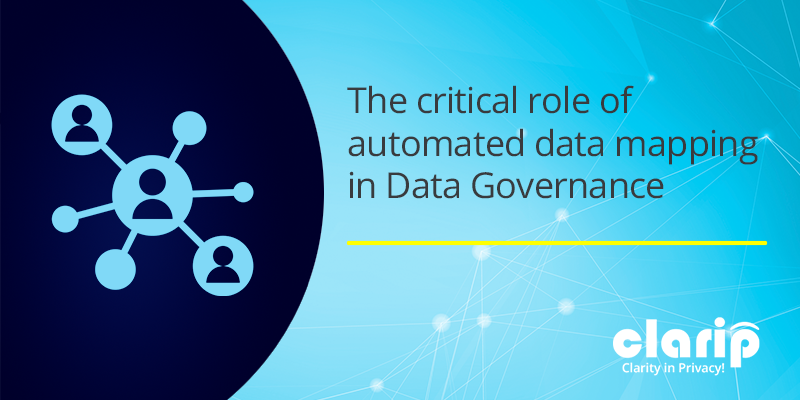The critical role of automated data mapping in Data Privacy Governance

When massive amounts of PII are generated, collected, and processed at an exceptional rate, consumer data privacy becomes a paramount concern for regulators. With the implementation of comprehensive data privacy regulations, organizations worldwide are under increasing pressure to establish robust data privacy governance frameworks. At the heart of effective data privacy governance lies the process of data mapping. This article explores the significance of data mapping in data privacy governance, its role in ensuring compliance across your market, mitigating risks, and how automating data mapping vastly improves this process.
Understanding Data Mapping
Data mapping is the systematic process of identifying, documenting, and organizing the flow of data within an organization. It involves identifying all data sources, the types of data collected, how it is stored, processed, shared, and deleted. Data sources can be structured, unstructured, and a hybrid of both. The process aims to create a comprehensive overview of an organization’s data landscape, facilitating effective data privacy governance.
Importance of Data Mapping in Data Privacy Governance
Regulatory Compliance: Data mapping plays a pivotal role in achieving and maintaining regulatory compliance. By mapping data flows, organizations can identify and assess which data privacy regulations are applicable to them, ensuring that personal data is processed lawfully and transparently. It helps in creating accurate data inventories and data protection impact assessments, enabling organizations to implement appropriate technical and organizational measures as mandated by regulatory frameworks.
Risk Identification and Mitigation: Effective data privacy governance involves identifying and mitigating potential risks to personal data. Data mapping allows organizations to identify vulnerabilities, potential breaches, and security gaps in their data handling practices. It enables proactive risk assessment, allowing organizations to implement robust security measures, conduct privacy impact assessments, and develop incident response plans. By understanding the flow of personal data, organizations can implement necessary controls to safeguard against unauthorized access, breaches, or misuse.
Data Subject Rights Management: Data mapping assists organizations in efficiently managing data subject rights requests. By understanding the data’s journey and storage locations, organizations can quickly respond to requests related to data access, rectification, erasure, and portability. Data mapping ensures that personal data is readily identifiable, and relevant processes are in place to address data subject rights, fostering transparency and accountability.
Cross-Border Data Transfers: With globalization and digitalization, cross-border data transfers have become common. Data mapping helps organizations identify whether personal data is transferred internationally and ensures compliance with regulations related to cross-border data transfers. It allows organizations to implement appropriate safeguards, such as standard contractual clauses or binding corporate rules, to protect data when it moves across borders.
Enhanced Data Governance: Data mapping serves as a foundation for effective data governance. It helps organizations establish data stewardship, data classification, and data retention policies. By understanding data flows, organizations can enforce data minimization principles, ensuring that only necessary and relevant data is collected and retained. It facilitates the implementation of data protection by design and default, embedding privacy controls into systems and processes from the outset.
Manual vs. Automated Data Mapping
Manual data mapping refers to the process of manually identifying and linking data elements between different systems or databases. This typically involves constant human intervention, relying on expertise, experience, and meticulous attention to detail. Here are some key characteristics of manual data mapping:
- Human Involvement: Manual data mapping heavily relies on human analysts or data experts who manually analyze source and target data schemas, identify corresponding data fields, and create mappings.
- Time-Consuming: Manual data mapping can be a time-intensive task, especially when dealing with large volumes of complex data. It requires careful analysis, verification, and documentation, which can slow down the overall data integration process.
- Prone to Errors: Human involvement introduces the possibility of human error. Mismatched or incorrect mappings can lead to data inconsistencies, system failures, and costly rework.
Automated data mapping, as the name suggests, employs software tools and algorithms to automatically identify, match, and map data elements between different systems. Here are some key characteristics of automated data mapping:
- Speed and Efficiency: Automated data mapping significantly speeds up the data integration process by leveraging algorithms and machine learning capabilities. It can handle large volumes of data and complex mappings with relative ease, saving time and resources.
- Accuracy and Consistency: Automation reduces the risk of human error, ensuring accurate and consistent data mapping across different systems. The use of predefined rules and algorithms minimizes the likelihood of mapping discrepancies.
- Scalability: Automated data mapping can handle scalability requirements more effectively compared to manual mapping. It can efficiently process large datasets and adapt to changing data structures or business needs.
Automated data mapping is a vital component to data privacy governance, enabling organizations to navigate the complex landscape of data regulations, mitigates risks, and builds confidence with regulatory agencies. By mapping data flows, organizations gain a comprehensive understanding of how PII is collected, processed, stored, and shared, allowing them to establish appropriate controls. Data mapping serves as the foundation for regulatory compliance, risk mitigation, efficient management of data subject rights, cross-border data transfers, and overall enhanced data governance. As organizations continue to prioritize data privacy, investing in robust data mapping practices is crucial.
Clarip’s Data Privacy Governance Platform ensures compliance with all consumer privacy regulations. Implementing automated data mapping with Clarip’s patented auto-tagging and categorization technologies, organizations can take the guess work out of the data minimization scenarios. Clarip takes data privacy governance to the next level and helps organizations reduce risks, engage better, and gain customers’ trust!
Email Now:
Mike Mango, VP of Sales
mmango@clarip.com
Related Content:
Making the Case for Data Minimization
Automated Data Mapping
Data Discovery
Looking for Product Data Sheets?

 Data Risk Intelligence
Data Risk Intelligence Automated Data Mapping
Automated Data Mapping Do Not Sell/Do Not Share
Do Not Sell/Do Not Share Cookie Banner Solutions
Cookie Banner Solutions Consent & Preferences
Consent & Preferences Data Rights Requests
Data Rights Requests
